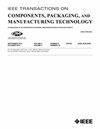Fabrication and Formation Principle of Porous Cu–Sn Bumps for Metal Bonding in Chiplet Integration
IF 2.3
3区 工程技术
Q2 ENGINEERING, ELECTRICAL & ELECTRONIC
IEEE Transactions on Components, Packaging and Manufacturing Technology
Pub Date : 2024-10-23
DOI:10.1109/TCPMT.2024.3485112
引用次数: 0
Abstract
We have developed porous Cu-Sn bumps by treating conventional Cu-Sn bumps with a gas mixture of oxygen and formic acid for fine-pitch Cu-Sn bonding and low-temperature Cu-Cu bonding. However, the formation mechanisms of the porous Cu-Sn bumps are still unclear, and the fabrication processes are not optimized. This article presents a chemical model for the formation of the porous Cu-Sn bumps. Controlled experiments are performed to investigate the influences of some key factors, such as the temperature and the duration of redox treatment, the gas composition, and the bump sizes. It is found that the formation of porous Cu-Sn bumps is associated with the sequential oxidation and reduction of the Cu-Sn intermetallic compounds (IMCs) as well as the thermal decomposition of their reaction products. Based on these results, a chemical model is proposed for the formation of porous Cu-Sn bumps, which provides deep insights to the reactions and the guidelines for optimizing the porous Cu-Sn bumps.微晶片集成中金属键合用多孔Cu-Sn凸点的制备及形成原理
我们用氧气和甲酸的混合气体处理传统的Cu-Sn凸起,开发出多孔的Cu-Sn凸起,用于细距Cu-Sn键合和低温Cu-Cu键合。然而,多孔Cu-Sn凸起的形成机制尚不清楚,制备工艺也未得到优化。本文提出了多孔铜锡凸点形成的化学模型。通过对照实验研究了温度、氧化还原处理时间、气体组成、肿块大小等关键因素对氧化还原过程的影响。研究发现,多孔Cu-Sn凸起的形成与Cu-Sn金属间化合物(IMCs)的连续氧化还原及其反应产物的热分解有关。在此基础上,提出了多孔Cu-Sn凸点形成的化学模型,为多孔Cu-Sn凸点的反应和优化提供了指导。
本文章由计算机程序翻译,如有差异,请以英文原文为准。
求助全文
约1分钟内获得全文
求助全文
来源期刊

IEEE Transactions on Components, Packaging and Manufacturing Technology
ENGINEERING, MANUFACTURING-ENGINEERING, ELECTRICAL & ELECTRONIC
CiteScore
4.70
自引率
13.60%
发文量
203
审稿时长
3 months
期刊介绍:
IEEE Transactions on Components, Packaging, and Manufacturing Technology publishes research and application articles on modeling, design, building blocks, technical infrastructure, and analysis underpinning electronic, photonic and MEMS packaging, in addition to new developments in passive components, electrical contacts and connectors, thermal management, and device reliability; as well as the manufacture of electronics parts and assemblies, with broad coverage of design, factory modeling, assembly methods, quality, product robustness, and design-for-environment.
 求助内容:
求助内容: 应助结果提醒方式:
应助结果提醒方式:


